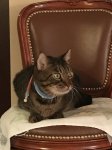Liz & Minnie
Very Active Member
yesterday
Just talked to vet - this time internist looking after her instead of ER vet. Potassium still low, rising slowly. Waiting on blood work including lipid levels/affect of bezafibrate. Eating is "good" (scale is excellent/good/handfed/zero interest).
BG has been upper 200s so they gave no R but she had a hypo last night 4-5am and they gave her dextrose. Checking hourly with the Libre and she's currently low 150-160s. She will be there at least til tomorrow, discharge depends on potassium levels.
I need to make a decision on esophogeal feeding tube by this time tomorrow, I said not to do it today (they do it late afternoon and need to schedule around noon. I predict she will still be there tomorrow and maybe another day). Tube 'should' be temporary til we get her through this. I do not want her with a permanent tube, I worry about QOL.
Interested in hearing experience with esophogeal feeding tubes. @Suzanne & Darcy I know you mentioned it. I don't want her suffering. Vet said lots of patients do well with them. I asked what she would do if it was her cat and she said "I'd be thinking really hard" (a little helpful but not too much)
Thanks.
Just talked to vet - this time internist looking after her instead of ER vet. Potassium still low, rising slowly. Waiting on blood work including lipid levels/affect of bezafibrate. Eating is "good" (scale is excellent/good/handfed/zero interest).
BG has been upper 200s so they gave no R but she had a hypo last night 4-5am and they gave her dextrose. Checking hourly with the Libre and she's currently low 150-160s. She will be there at least til tomorrow, discharge depends on potassium levels.
I need to make a decision on esophogeal feeding tube by this time tomorrow, I said not to do it today (they do it late afternoon and need to schedule around noon. I predict she will still be there tomorrow and maybe another day). Tube 'should' be temporary til we get her through this. I do not want her with a permanent tube, I worry about QOL.
Interested in hearing experience with esophogeal feeding tubes. @Suzanne & Darcy I know you mentioned it. I don't want her suffering. Vet said lots of patients do well with them. I asked what she would do if it was her cat and she said "I'd be thinking really hard" (a little helpful but not too much)
Thanks.
Last edited:

 Hugs to you and Minnie
Hugs to you and Minnie 



